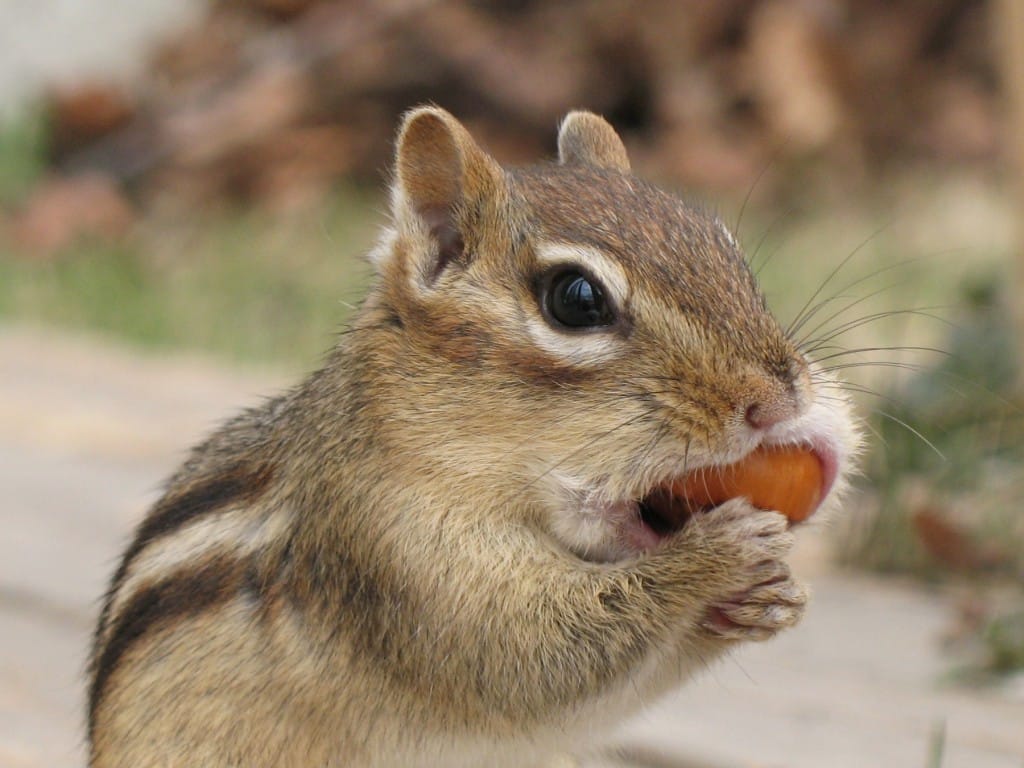Source(s): Michael T. Mengak, Ph.D., Associate Professor and Wildlife Outreach Specialist, Warnell School of Forestry and Natural Resources, The University of Georgia.
The Eastern Chipmunk is one of the smaller members of the squirrel family, measuring 8 to 10 inches long. Chipmunks are primarily ground dwellers, but they do climb trees and shrubs for food and protection when necessary. They may be identified by the three dark dorsal stripes on the otherwise reddish-brown coat and by its habit of running with its tail sticking straight up in the air.
Chipmunks and their Behavior
Chipmunks are quick in movements and very alert to danger. They prefer open wooded areas with plenty of food-producing trees and bushes. Food and protection offered by shrubbery, flowers, gardens and various types of landscaping attract chipmunks; and it is in these conditions that most problems arise. The cute, playful little creature then becomes a pest that threatens the appearance and the well-being of a home.
The Eastern Chipmunk has an extensive burrow system that may be 30 feet or more in length with one or more hollowed out cavities where young are reared. Openings are usually at the bases of stumps or fallen logs or beside large stones or walls. Entrances and exits of the burrow system are kept free of excavated dirt.
Chipmunks eat grain (corn), nuts (acorns), seeds (sunflower or other seed in a bird seed mix), mushrooms, insects (caterpillars) and some carrion (dead animal tissue), although this is a rare item in their diet.
Damage
Chipmunks are territorial and rarely become abundant enough to cause a lot of damage. Individuals will gnaw into bags containing dog food or bird seed. They will also dig up and consume flower bulbs. Occasionally they will gnaw the bark from shrubbery.
Repellents
Naphthalene crystals (“mothballs”) may repel chipmunks from sheds, attics or summer cabins. The quantity required is usually so great that the odor is offensive to humans. There are no registered repellents for chipmunks. Taste repellents containing bitrex, thiram or ammonium soaps of higher fatty acids can be applied to landscape plants. Products such as Ro-Pel®, Hinder®, Big Game Repellent® or This-1-Works® are commercially available from garden supply stores, feed stores and forestry catalogs. There are no fumigants or toxicants registered for controlling chipmunks.
Trapping
Trapping is the easiest method to control chipmunks. The large wooden base snap traps used in rat control are effective in chipmunk control. Peanut butter alone or mixed with oatmeal makes good bait. Place traps along runways at burrow openings or in other areas of chipmunk activity. Place snap traps perpendicular to the wall or near burrow entrances. Homeowners can use live traps such as Havahart (No. 0) or Tomahawk (No. 102). Garden and feed stores generally sell these traps.
Exclusion
Exclude chipmunks from buildings whenever possible. Seal holes where gas lines, cooling lines or cable TV enter the house. Use caulking or ¼ inch welded wire. Attach a homemade screen to the bottom of a clothes dryer vent if the vent is near the ground.
Shooting
If safe to do so, shooting can be effective. Use only a .22 caliber rifle with pellets or an air rifle (BB gun). Check local ordinances. It is often illegal to discharge any firearms inside city limits.
Legal Status
ALL non-game wildlife is protected in Georgia. Therefore, it is illegal to kill any species unless specifically permitted by regulations such as hunting and fishing laws. Check with your local conservation office. Generally, homeowners can protect their property from mammals causing or about to cause damage. This does not allow citizens to kill wildlife out of season or in violation of federal, state or local laws or ordinances. Contact police or local Wildlife Resource Division personnel.
Reviewer(s): Michael T. Mengak, Ph.D., Associate Professor and Wildlife Outreach Specialist, Warnell School of Forestry and Natural Resources, The University of Georgia, July 2006.
Center Publication Number: 211
- Evaluating Attractants for Live-Trapping Armadillos - September 23, 2013
- Snakes and Their Control - September 23, 2013
- Copperheads - September 22, 2013
